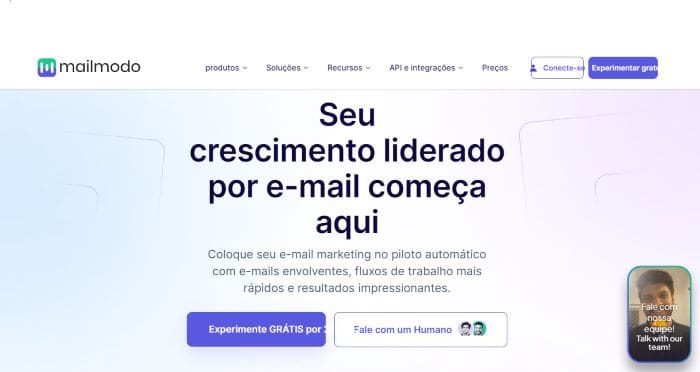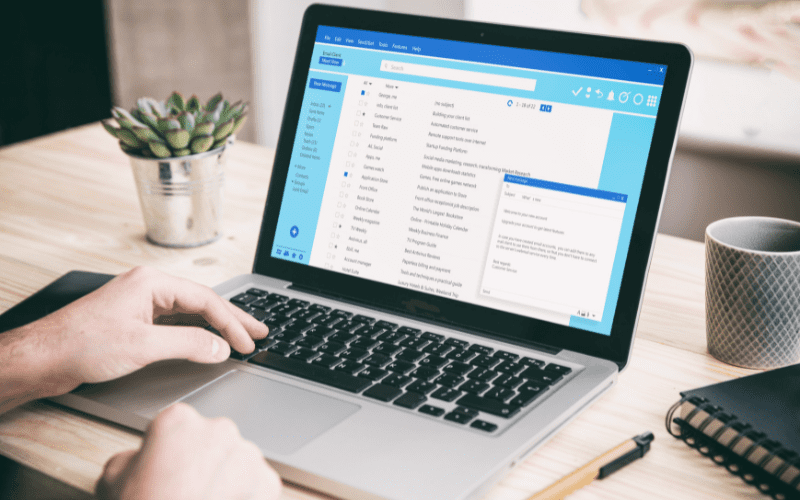
If you're a marketer involved in email campaigns, you've certainly experienced the frustration of having brilliant ideas but not enough time to turn them into reality.
The battle to transcribe your intentions into appropriate text, fine-tune details and achieve visual perfection can be exhausting. However, with the right Artificial Intelligenceyou can leave these worries behind and gain precious time in your day.
In this article, you'll learn about the best AI tools available, which will revolutionize your routine and deliver high-quality emails.
What is Email Marketing?
It's a digital marketing strategy that involves sending commercial messages by email to a segmented list of contacts.
The aim is to establish a relationship with customers, promote products/services, strengthen the brand and generate sales.
In the past, email was mainly used to exchange messages, but marketers have realized its potential as an advertising channel.
However, the misuse of email marketing has resulted in unwanted messages and blockages by email providers.
To get around this, companies have adopted more qualified practices, such as obtaining permission from recipients, segmenting contact lists and personalizing messages.
Today, email marketing is a powerful tool, offering significant results when used correctly.
Why Use Email Marketing?
Email is an important channel for campaigns and communication in general. Despite speculation about its lifespan, it is still an essential form of business communication, with more than 50 years of existence.
Here are some reasons to use email in your marketing strategy.
Wide reach
Email marketing offers the opportunity to communicate with a large number of people directly and at the right time. In this sense, the benefits of automating processes brings significant scalability to businesses.
According to Hubspot, around 4 billion people access their emails every day around the world. In Brazil, this strategy is particularly effective, with an email open rate of 20.39% and more than 8 billion messages sent every day.
One of the advantages of email marketing is the ability to reach people in different geographical locations, overcoming physical barriers. No matter where your recipients are, you can send your messages and reach them.
Furthermore, email is widely used and accessed by people of all age groups and demographic segments.
Delivery Predictability
One of the advantages of email marketing is the ability to have a predictable reach. When you send an email, you have control over who will receive your message, ensuring that it reaches the intended recipients.
Unlike other marketing channels, where reach can depend on algorithms or audience availability, email marketing allows you to target your messages to specific contacts.
Enables Segment message sending
Instead of sending a generic message to your entire list, you can target your campaigns based on specific criteria, such as interests, buying behaviors, demographics or stage of the sales funnel.
Segmentation allows you to send highly relevant and personalized messages, increasing the chance of engagement and conversion. By getting to know your target audience better, you can tailor email content to meet their specific needs and interests.
For example, if you own a clothing store, you can segment your contact list based on gender, sending specific campaigns to men and women with products and offers relevant to each group.
Flexible formats
With email marketing, you can create personalized, informative or promotional messages according to the objectives of your campaign. You can use different formats, such as newsletters, bulletins, invitations, catalogs, etc.
In addition, email marketing allows you to incorporate attractive visual elements such as images, graphics, call-to-action (CTA) buttons, social media icons and even animations. These visual resources help to make your messages more attractive, engaging and impactful.
In addition, email marketing is compatible with different devices, such as smartphones, tablets and desktops, ensuring that your messages are viewed correctly on whatever device your recipients are using.
High Return on Investment
Have you ever stopped to think about the incredible return on investment that email marketing provides? It's impressive! According to data from Litmus in 2019, the average return is $42 for every $1 invested.
And what explains these significant financial results? Basically, the low investment required and the high conversion rates.
To start your email marketing strategy, you only need three simple ingredients: a domain, a sending tool and someone to execute the strategy.
Nurturing Leads and Customers
Through email marketing, you can inform contacts about your business, establishing a close relationship. With relevant and personalized content, leads understand the value you offer and mature their purchasing decision.
Email is the ideal channel for this nurturing journey. With automation, personalized messages are sent at the right time, according to the stage of the buyer's journey. This strengthens engagement, maintains interest and boosts conversion over time.
Nurturing existing customers is equally important. Email marketing allows you to maintain relationships, offer product updates, provide after-sales support and send exclusive offers. This strengthens customer satisfaction, increases loyalty and encourages repeat purchases.
Great value for money
In terms of costs, email marketing is an affordable option. The investment required to set up and run email campaigns is relatively low compared to other marketing channels such as print or television advertising.
In addition, there are various marketing automation tools and email marketing platforms available, which we'll explore later.
Possibilities for A/B Testing
O A/B test is an essential practice in email marketing. It consists of sending two different versions of the same email to different segments of your contact list in order to identify which version generates the best results.
This technique allows you to evaluate different elements such as the subject of the email, the layout, the call to action (CTA) or even the time it was sent.
By analyzing performance metrics such as open rates, clicks and conversions, you can identify which version of the email got the best engagement and thus improve your strategies in a data-driven way.
Brand Awareness
Email marketing plays an important role in strengthening brand awareness. By sending regular emails to your contact list, you keep your brand present in the minds of recipients and reinforce your identity.
Email marketing offers effective strategies for building recognition and long-lasting relationships with your target audience.
Personalizing the design and content of emails, along with segmenting the contact list, increases the relevance of messages. These approaches certainly strengthen engagement and contribute to a greater connection with recipients.
The Importance of Email Marketing in Your Strategy
Learn about some of the roles that email marketing can play in your strategy and that you can adopt in your planning.
Strengthening Relationships
Email marketing is a form of personal and direct communication with consumers, offering a unique opportunity to strengthen relationships. Users have already given permission to receive your messages, showing interest in connecting with your brand.
Take advantage of this opportunity to keep your brand present and active in consumers' minds. Deliver valuable content and useful offers that add value to their lives.
It's important to remember that email marketing allows for two-way communication. You need to pass on information, listen to your customers, understand their needs and answer their questions. This continuous interaction strengthens the bond and promotes a lasting relationship.
Promoting Content
Email marketing plays a crucial role in promoting your content. It's an effective way of sharing your articles, blog posts, videos or any other type of content you produce.
By using email marketing to promote your content, you reach your audience directly, providing them with exclusive and relevant access to your material. This helps to increase the visibility of your content, drive traffic to your website or blog and build an engaged reader base.
Selling
In the world of email marketing, you have the opportunity not only to strengthen relationships and promote relevant content, but also to make direct sales.
Be inspired by the possibility of sending emails with irresistible offers and tempting discounts, taking your recipients directly to the purchase page. With just a few clicks, you can boost sales.
A recent study by Klavyio revealed that email marketing can account for more than a quarter (27%) of the overall revenue of online stores. Take advantage of this valuable opportunity and make email marketing your ally in successfully promoting and selling your products.
After-sales service
As well as boosting sales, this is a powerful tool for maintaining customer relations after the purchase.
Through email marketing, you can send follow-up messages, provide after-sales support, send updates on products or services, and even ask for customer feedback.
These continuous interactions demonstrate care and attention, showing customers that their satisfaction is a priority.
Post-sales email also allows you to offer customers new opportunities. You can send complementary product recommendations, exclusive promotions or loyalty programs to encourage repeat purchases.
Most Used Types of Email Marketing
Learn about some of the emails used in different marketing strategies.
Welcome
 The welcome email is sent as soon as the consumer opts in to receive your campaigns.
The welcome email is sent as soon as the consumer opts in to receive your campaigns.
It should be sent automatically as soon as the customer registers, so that they feel promptly attended to by your company.
It is essential to keep the customer informed from the first email contact, so that they have a clear idea of what to expect from your company and feel welcomed from the start.
Interactive

These are emails that allow recipients to interact with the content directly from their inbox, without the need to redirect to another page.
These emails usually include interactive features such as clickable buttons, drop-down menus, image carousels and fillable forms.
Learn more about how this feature can offer recipients a more dynamic and engaging experience when interacting with this type of content.
Interactive Email Marketing: Best Practices with Mailmodo by Pareto
Newsletter
 A newsletter is one of the most common types of email marketing. It consists of sending regular email newsletters to a list of customers.
A newsletter is one of the most common types of email marketing. It consists of sending regular email newsletters to a list of customers.
Newsletters generally contain relevant information, updates, news, articles, tips, promotions and other content related to the interests of the target audience.
They are sent out on a regular basis, such as weekly, monthly or quarterly, and aim to keep customers informed and engaged with the brand, providing valuable content and keeping them up to date on industry news, product launches, events, and more.
They can contain links to the company's website, blog posts, social networks and other CTAs, allowing subscribers to access more information and interact with the brand in different ways
Promotional
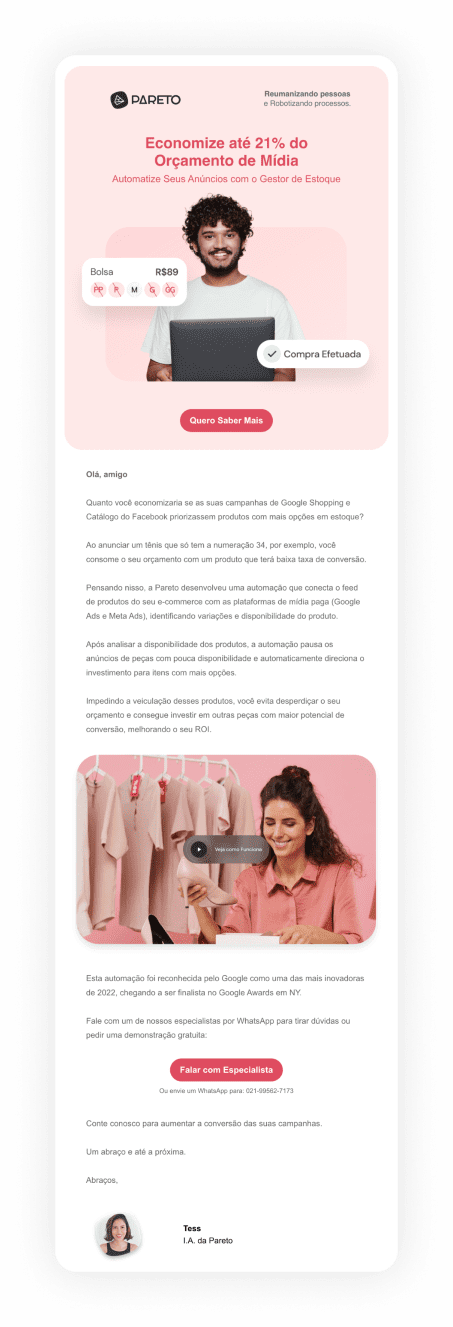 Promotional emails are another common type of email marketing. It is sent with the aim of promoting products, services or special offers to the customers on the list.
Promotional emails are another common type of email marketing. It is sent with the aim of promoting products, services or special offers to the customers on the list.
They usually feature information about discounts, sales, product launches, giveaways, coupons or any other offer that encourages recipients to take action, such as making a purchase, taking advantage of a limited promotion or registering for an event.
These emails usually have an attractive design, with images and persuasive text to highlight the benefits of the offer and encourage recipients to take action. They can also contain direct links to the purchase page or a specific landing page.
Seasonal
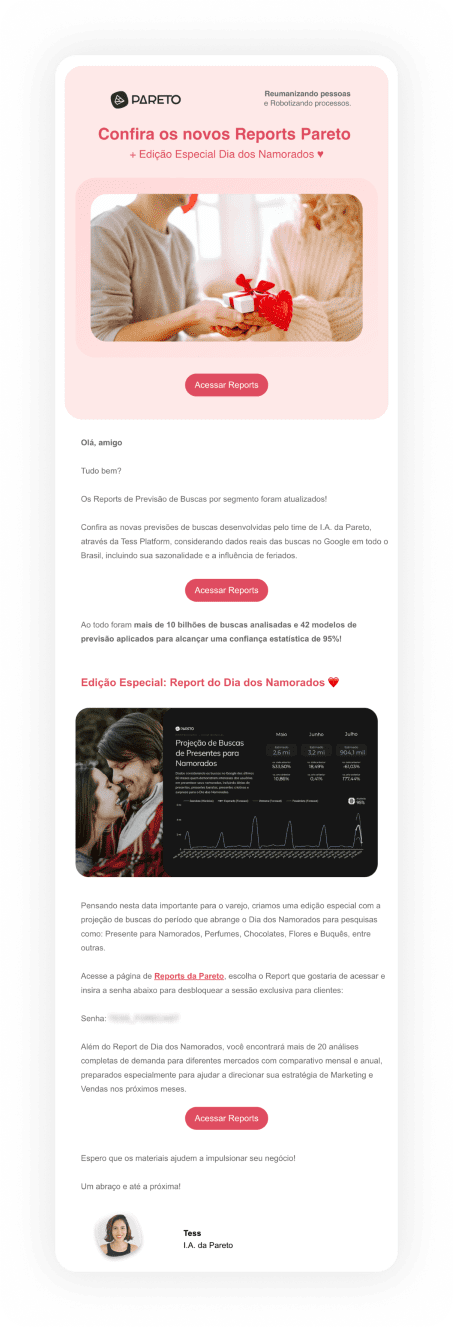 Seasonal email is a type of email marketing sent on specific occasions such as holidays, commemorative dates like Valentine's Day or Father's Day; seasonal events or specific promotional periods like Black Friday.
Seasonal email is a type of email marketing sent on specific occasions such as holidays, commemorative dates like Valentine's Day or Father's Day; seasonal events or specific promotional periods like Black Friday.
This type of email is designed to take advantage of the seasonal climate and create relevance with the target audience during these periods.
This could include seasonal promotions, special offers, themed messages, gift suggestions, decorating tips, recipes, events or any content related to the specific occasion.
This type of email can help brands stand out, create a sense of urgency and generate greater engagement and conversions from recipients during times when they are most likely to engage with certain types of products or services.
Transactional
 Transactional emails are crucial in company-customer communication and are sent in response to specific user actions, such as registrations, purchases or support requests.
Transactional emails are crucial in company-customer communication and are sent in response to specific user actions, such as registrations, purchases or support requests.
They provide relevant information in a clear and direct way, but they can also improve the customer experience. For example, a welcome email can offer initial content for new users, while an order delivery confirmation email can suggest complementary products.
Big Brand Email Marketing Templates
Here are examples of how Airbnb, Amazon and Spotify use email marketing to engage their customers.
Airbnb
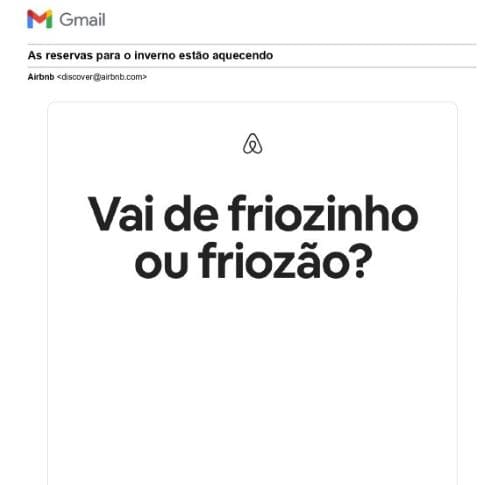

 Airbnb uses email marketing as an effective way of communicating with its users, both hosts and guests. They send personalized emails based on users' travel preferences, offering suggestions for destinations, accommodation and exclusive experiences.
Airbnb uses email marketing as an effective way of communicating with its users, both hosts and guests. They send personalized emails based on users' travel preferences, offering suggestions for destinations, accommodation and exclusive experiences.
In addition, Airbnb uses emails to encourage booking, sending reminders of available dates, seasonal discounts and special offers. They also send post-trip messages, asking for reviews and feedback from guests, contributing to the platform's reputation and trust.
Amazon

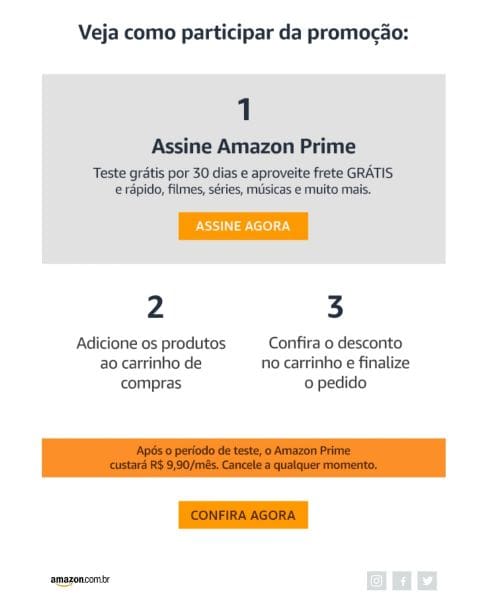 Amazon sends emails with product recommendations based on the customer's previous purchases. It also sends notifications of special promotions, seasonal discounts and flash deals.
Amazon sends emails with product recommendations based on the customer's previous purchases. It also sends notifications of special promotions, seasonal discounts and flash deals.
In addition, it uses strategies such as cart abandonment, sending reminders to customers who have left items in the cart without completing the purchase.
Not to mention sending out order confirmation emails, delivery updates and product evaluation requests, which you will no doubt have already received.
Spotify

 Spotify uses email marketing to send users personalized playlists based on their musical tastes, releases from artists they follow and recommendations of new music and podcasts based on their listening history.
Spotify uses email marketing to send users personalized playlists based on their musical tastes, releases from artists they follow and recommendations of new music and podcasts based on their listening history.
They also send emails with offers for premium plans, news about the app's features and invitations to music-related events or festivals.
How to Plan an Email Marketing Campaign in 5 Steps
To be successful with a campaign, you need to plan it well. Here are some crucial points to take into account.
1. Define the Objectives of Your Campaign
When planning an email marketing campaign, it is essential to define clear objectives. Consider the main purpose of the campaign, such as increasing sales, generating leads, promoting a new product/service or strengthening customer relations.
2. Know the Persona You're Communicating With
When planning an email marketing campaign, it is crucial to identify the persona you want to communicate with. This is the description of a semi-fictitious character who represents your business's ideal customer, encompassing all their needs, pains and interests at each stage of the journey.
Understanding your persona will help you personalize your email messages, making them more relevant and engaging for your target audience
3. Build Your Contact List
Thinking strategically about how to expand and strengthen your contact base is a vital step in email marketing planning. After all, without a solid list, no strategy can reach its full potential!
There are various approaches to attracting and winning over valuable email addresses. You can implement strategic forms on your website, create irresistible landing pages, offer valuable content and exclusive materials in exchange for the email address.
4. Choose the Targeting Criteria
Nowadays, email marketing requires segmentation to ensure that the messages sent are relevant to each recipient. It is not advantageous to send the same email to the entire list, as interests and stages of purchase vary.
To segment your list, you can consider criteria such as demographic characteristics, specific interests, interaction history and stage in the sales funnel. This will ensure that each person receives personalized content tailored to their needs.
5. Plan the Frequency of Triggers
The frequency of email marketing campaigns varies according to the strategy and preferences of your contact list.
Some important guidelines are to maintain consistency, avoid excesses, carry out tests and monitor results, as well as considering the segmentation of the list to adjust the frequency of mailings.
Find a balance between staying present and providing valuable content, without overloading your contacts with too many emails.
Consider Some Elements in Your Marketing Strategy
To create a good marketing strategy for your campaigns, it's important to consider some crucial elements. See below.
Sender
The sender is the identity behind the marketing message. It's important to use a recognizable sender, such as your company name, relevant contact person, etc.
A trusted sender increases the likelihood that the recipient will open the message and find it relevant. For example, the sender of Pareto is Tess AI, representing the artificial intelligence behind the services offered.
Address size
When considering the length of the sender's address, the company opts for a concise and professional format. For example, Pareto uses the address"tess@pareto.io".
As you can see, it is short, simple and related to the company's brand. By choosing a sender address like this, the company is trying to convey a professional and trustworthy image to its recipients.
This makes it easier to recognize the sender and increases the likelihood that your emails will be opened and considered relevant by the recipients.
Email subject
The subject line of the email plays a crucial role in the open rate of the message. It is important to create an attractive, concise and captivating subject line that arouses the recipient's curiosity and encourages them to open the email.
It must be relevant, personalized and offer a clear benefit to the reader, and can be informative, promotional or other.
CTA + Conversion Button
The CTA (Call to Action) is an essential part of your marketing email. It is responsible for directing the reader to the desired action, such as making a purchase, filling in a form or subscribing to a newsletter.
An effective CTA must be clear, direct and visible. A well-designed conversion button with persuasive text can also increase the click-through rate and user engagement.
Social media links
Including links to your social media pages is an excellent way to promote your online presence and interact with your audience.
These links allow recipients to connect with your brand on different platforms, share your content and take part in relevant conversations. Make sure you include icons that are visible and directed to your social media pages that are most relevant to your audience.
Unsubscribe option
Offering recipients the option of unsubscribing from your mailing list is essential to respecting their preferences and privacy.
This shows that you value the recipient's choice and helps prevent your brand from being perceived as spam. Make sure you include an easy-to-find and easy-to-use link so that recipients can unsubscribe without difficulty, even if this means something negative for you.
Key Email Marketing Metrics
When analyzing an email marketing campaign, there are several important metrics that can provide insights into the performance and impact of your strategies. Some essential metrics to analyze are:
Opening Fee
The open rate in an email campaign is the percentage of recipients who actually opened the email in relation to the total number of recipients who received the email.
To calculate the open rate, you divide the number of emails opened by the total number of emails delivered and multiply the result by 100 to get the percentage. However, most email marketing tools already provide this metric directly in the results report.
Generally, an open rate considered good is at least 15%. However, this percentage can vary depending on the sector and the type of email sent.
Several factors can affect the open rate of emails, including direct delivery to the recipient's inbox, preventing them from being filtered into folders such as "Promotions" or "Updates" or even directed to the spam box.
Click-through rate
The click-through rate represents the percentage of recipients who clicked on a link within the email, in relation to the total number of emails delivered.
The calculation of this metric is similar to that of the open rate. Simply divide the number of emails clicked by the number of emails delivered and multiply the result by 100. A good click-through rate is generally above 2% on average.
Some tools provide CTR, which calculates clicks in relation to the number of emails opened, rather than the total number of emails delivered. This approach results in a higher percentage. However, a high CTR doesn't always indicate a successful campaign, as it can inflate the results.
To guarantee an above-average click-through rate, it's important to include calls to action (CTAs) with external links in the email content, in order to arouse the recipient's interest in accessing additional content or taking a specific action.
Conversion Rate
Conversions represent the crucial stage of an email marketing campaign, as they indicate whether the results obtained have really contributed to the digital marketing strategy.
Measuring conversions is essential for evaluating campaign performance in line with your objectives. This can include generating new leads, converting leads into qualified leadsbusiness opportunities or customers, as well as specific sales of products or services.
In addition to viewing the results in the reports of the email sending tools, you can track conversions on your e-commerce platform, if applicable, or even in Google Analytics.
The main email sending tools allow you to tag the links in your emails, making the URLs traceable and allowing you to analyze the channel's performance separately in Google Analytics.
It is also important to evaluate the conversion rate of clicks on emails in relation to actual conversions. If this rate is low, it indicates the need to optimize the landing page or consider using a landing page, if one is not already being used.
Unsubscribe rate
The unsubscribe rate represents the number of people who received the email and chose to click on the unsubscribe link, indicating that they no longer wish to receive emails from the sender.
It's important to keep campaigns with an unsubscribe rate of no more than 1% of the total number of recipients.
Between marking as spam and unsubscribing, it is preferable for the contact to unsubscribe, as this has less impact on the deliverability of the emails. For this reason, it is crucial that all emails include a clear unsubscribe option for the user.
When a user unsubscribes from the list, the mailing tool automatically removes their email permanently from future mailings, eliminating the need to manually remove the user from the list.
This unsubscribe metric reveals possible problems in the email sending schedule or in the quality of the content sent.
A significant increase in the unsubscribe rate is a warning that the company needs to review and reformulate its strategy as a whole, looking for ways to reverse the situation and improve the user experience.
Delivery fee
The delivered email rate represents the number of recipients who successfully received the email, expressed as a percentage of the total number of emails sent.
Emails that have not been delivered are generally classified as bounces, which can behardbounces (permanent failures) orsoftbounces (temporary failures).
There are two main reasons why an email may not be delivered: authentication problems, such as incorrect SPF, DKIM or DMARC settings, or problems with the recipient's email address, such as a full inbox, a non-existent address or the destination server being blocked.
Some email sending tools, such as RD Station, can block the sending of emails if the delivery rate remains low during sending, in order to preserve the reputation of the sending server.
To maintain a high email delivery rate, it is essential to avoid buying email lists, registering emails manually or sending to out-of-date contact lists.
In addition, sending messages to more segmented contact lists can have a positive impact on the delivery rate, as it directs messages to more relevant and engaged recipients, improving the likelihood of successful delivery.
In general, a good email delivery rate is 98% or more.
Rejection rate
The bounce rate is the percentage of emails that were rejected by the recipient's server in relation to the total number of emails sent. This metric is directly related to emails that were not successfully delivered.
There are two types of rejection: soft bounce (temporary rejection) and hard bounce (permanent rejection), as explained above.
Soft bounce occurs when the message cannot be delivered temporarily due to reasons such as the recipient's inbox being full, problems with the recipient's mail server or the server being temporarily offline.
It's important to note that a soft bounce is not a permanent failure and messages can usually be successfully delivered in future attempts.
Hard bounce occurs when the message cannot be delivered permanently, usually due to a non-existent email address, the destination server being blocked or other permanent reasons.
In such cases, it is unlikely that the messages will be delivered on future attempts, as there is a fundamental problem with the email address or the destination server.
To maintain a good bounce rate, it is recommended to keep soft bounce below 5% and hard bounce below 3%. Monitoring these metrics is essential in order to preserve the deliverability of future emails and avoid problems such as blocking or a damaged sender reputation.
ROI rate
This is a metric that calculates the return on investment in an email marketing campaign. It is important for evaluating the effectiveness and financial performance of the campaign.
To calculate the ROI rate, you need to compare the value generated with the campaign (for example, revenue from sales, conversions or qualified leads) with the total cost of the campaign (including design costs, sending emails, automation tools, etc).
A positive ROI rate indicates that the email marketing campaign generated a favorable financial return on the investment made.
For example, if you spent R$1,000 on an email campaign and obtained R$5,000 in revenue, the ROI would be 400% (5,000 - 1,000 = 4,000; 4,000 / 1,000 = 4; 4 x 100 = 400%).
The ROI rate is an essential metric for evaluating the performance of your email marketing campaigns, identifying which strategies are bringing the best results and making informed decisions about future investments.
By analyzing these metrics, you will be able to spot trends, identify strengths and weaknesses in your campaign and make informed decisions to optimize the performance of your email marketing.
Understanding Email Deliverability
Imagine email deliverability as an exciting and challenging journey to reach your recipient's inbox. When you send an email marketing message, it embarks on a journey through the world of email servers. But beware, there are checkpoints along the way!
These checkpoints are like strict borders that verify that your email is authentic, relevant and secure. Some emails are barred and sent to an isolated island called "spam", where no one can see them.
But emails that pass through the checkpoints reach their final destination, either in the inbox or in the uncertain spam box.
To ensure that your email is successful on this journey, you need a good reputation, with a clean track record and reliable practices. In other words, the better the reputation, the better the deliverability.
Watch out for negative signals, such as bounces and spam complaints, which can disrupt your marketing strategy.
Authentication and Security Information
Authentication and security in email marketing involve measures to guarantee the legitimacy of emails and prevent fraud. Some of the main security mechanisms are:
- SPF (Sender Policy Framework): authorizes the sending of emails on behalf of a domain, configured through a DNS record;
- DKIM (DomainKeys Identified Mail): checks whether the message has been altered along the way, ensuring the integrity and authenticity of the content;
- DMARC (Domain-based Message Authentication, Reporting and Conformance): configuration that requires SPF and DKIM to be correctly configured, determining the treatment of emails that fail the previous checks;
- Whitelabel: allows the email sending tool to use the sender's domain, making it indistinguishable from direct sending by the company;
- Sender ID: a method similar to SPF, developed by Microsoft for its email services, such as Hotmail and Outlook;
- Reverse DNS: verification carried out by mail servers to confirm the identity of the sender through the domain corresponding to the IP address;
- Feedback Loop: notification of spam marking, enabling action to be taken against unwanted senders;
- WHOIS: online registry that identifies the owner of a domain, used by some email servers to verify the authenticity and veracity of the sender.
9 Best Email Marketing Tools
Discover the best automation tools on the market that will streamline your processes.
1. Mailmodo by Pareto
Say goodbye to dull emails! With Mailmodo, you can create engaging and attractive emails that capture the attention of your recipients from the very first moment.
This intuitive interface allows you to add interactive elements such as call-to-action buttons, polls, image carousels and much more.
Surprise your contacts with a unique interactive experience and boost interest in your products or services, without the need to be an expert in design or programming to create impressive emails.
Get higher conversions, engage your audience and see your results take off.
Learn more about the Mailmodo by Pareto. Try it for free for 21 days!
2. MailChimp
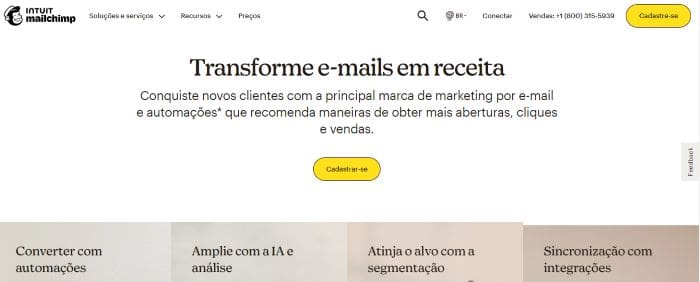 It offers comprehensive features for creating and managing email campaigns, including customizable templates, marketing automation, contact list segmentation and performance analysis.
It offers comprehensive features for creating and managing email campaigns, including customizable templates, marketing automation, contact list segmentation and performance analysis.
One of the highlights is the possibility of integrating with platforms such as WordPress, Shopify and Magento.
3. Nitronews
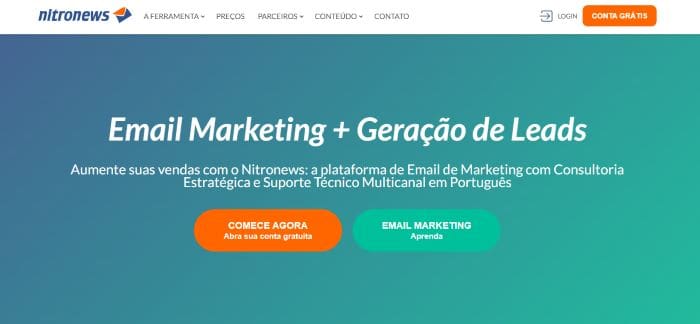 Nitronews is a complete email marketing tool that goes beyond sending email campaigns. With features such as landing pages, Whatsapp support and pop-up forms, you can capture leads and expand your contact base easily and efficiently.
Nitronews is a complete email marketing tool that goes beyond sending email campaigns. With features such as landing pages, Whatsapp support and pop-up forms, you can capture leads and expand your contact base easily and efficiently.
One of the great advantages of Nitronews is its intuitive and clean interface, which makes the process of sending emails and analyzing reports quick and simple. With just a few clicks, you can set up and fire off your campaigns and monitor the results in real time.
4. Constant Contact
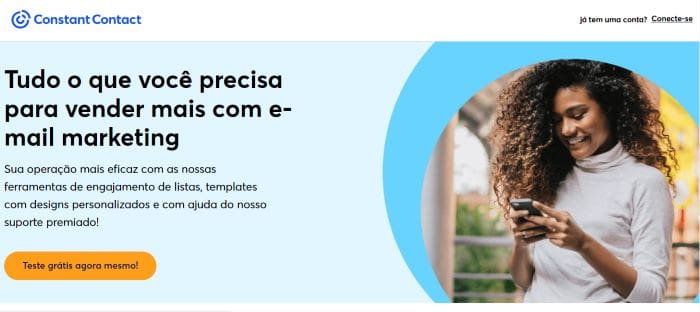 This is an interesting choice for small businesses that want to boost their online presence.
This is an interesting choice for small businesses that want to boost their online presence.
One of Constant Contact's main advantages is its ease of use, making it simple for companies and non-profit organizations to create high-quality email marketing campaigns.
With drag and drop, you can easily create and edit responsive email templates for mobile devices.
5. GetResponse
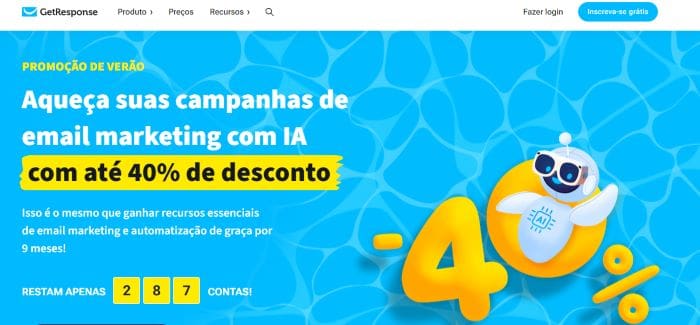 With this email marketing tool, you'll be able to send a sequence of automated, personalized emails at the right time to each of your contacts.
With this email marketing tool, you'll be able to send a sequence of automated, personalized emails at the right time to each of your contacts.
With the automation and autoresponder feature, you can set up a series of emails that will be sent on a scheduled basis, either daily or weekly. The best part is that the tool will ensure that these emails are delivered at the ideal time, according to the location of each contact.
What's more, you'll have access to detailed information about your subscribers and can assign specific tags to each one.
6. Drip
 Drip is a fast-growing marketing solution specially designed for e-commerce. It offers an innovative customer relationship management service called ECRM.
Drip is a fast-growing marketing solution specially designed for e-commerce. It offers an innovative customer relationship management service called ECRM.
The main objective of Drip's ECRM is to establish a closer connection with your customers. It has an impressive capacity to handle large volumes of data, surpassing traditional CRM solutions.
With Drip, you'll have a highly personalized marketing approach, making the most of your strategies.
This email marketing tool integrates and uses millions of customers' data across all your communication channels, allowing you to send email campaigns at the ideal time.
7. Brief
 Among the features on offer are a CRM for creating long-lasting relationships, marketing automation, audience segmentation, landing page creation and much more.
Among the features on offer are a CRM for creating long-lasting relationships, marketing automation, audience segmentation, landing page creation and much more.
Brevo is a comprehensive tool that combines email marketing and transactional email, allowing you to create effective campaigns and maintain a close relationship with your audience.
8. E-goi
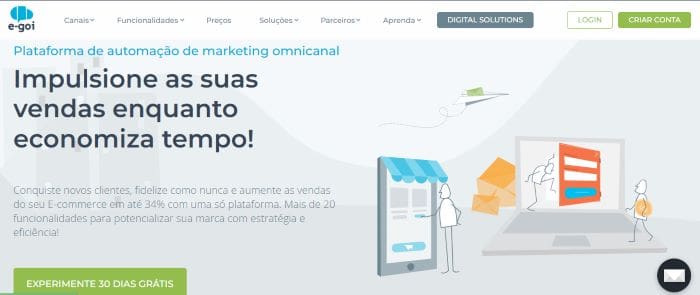 In the complete E-goi package, you'll have access to automated solutions for email and mobile devices, which include sending SMS, notifications and even voice calls.
In the complete E-goi package, you'll have access to automated solutions for email and mobile devices, which include sending SMS, notifications and even voice calls.
What's more, E-goi offers detailed reports to track the performance of your campaigns, such as open rates, clicks and conversions generated from triggers.
9. RD Station
 With RD Station, you'll have access to an email marketing platform that offers a wide range of pre-configured email templates and an intuitive drag-and-drop editor. This means you can easily create personalized emails, without the need for advanced technical knowledge.
With RD Station, you'll have access to an email marketing platform that offers a wide range of pre-configured email templates and an intuitive drag-and-drop editor. This means you can easily create personalized emails, without the need for advanced technical knowledge.
By integrating with your company's CRM platform, you'll have access to additional metrics to refine your strategies.
What Shouldn't Be Missing from Your Email Marketing?
In your email marketing checklist, it is essential to include the following items. See below:
Planning
- Define the persona and segment the contacts;
- Create relevant and personalized content;
- Establish a calendar with the day and time of the trigger.
Content Production
- Draw up an outline of the email;
- Write email texts with attention to detail;
- Select an impactful title from several options;
- Thoroughly review the content.
Email layout
- Create an attractive layout in line with the content;
- Review the layout together with the finished content;
- Carry out a test shot to check the subject, images, links and content.
Shooting
- Configure the campaign correctly and select the right segmentation;
- Schedule the trigger for the desired moment.
Analysis
- Track and analyze key metrics such as open rate, click rate and conversion rate.
By following this checklist, you will have a well-structured email marketing strategy and will be able to optimize your results through careful planning, production of quality content, attractive layout, efficient segmentation and continuous analysis of metrics.
The Main Mistakes You Should Avoid in Email Marketing
Check out what mistakes you should avoid to avoid jeopardizing your campaigns.
Buy Email Lists
Buying mailing lists is a common mistake you should avoid in email marketing. This practice can lead to negative consequences, such as low open rates, high bounce rates and damage to your brand's reputation.
What's more, these lists often contain disqualified contacts, people who are not interested in your products or services. It is much more effective to build an organic, permission-based contact list through lead capture strategies and proper nurturing
Frequent firing
Sending emails too often is another mistake you should avoid when it comes to email marketing. Sending messages too often can overwhelm your contacts and lead to them unsubscribing or even marking your emails as spam.
Consider that people are bombarded with information all the time, and that there isn't much time to read everything that arrives in their inbox.
Not Delivering What Was Promised
When you make an offer, whether it's exclusive content, a discount or anything else, it's essential to deliver on what you've promised. If you've promised a free ebook, for example, make sure you give it to your contacts in a clear and accessible way.
Not disappointing your customers' expectations is essential to building trust and maintaining a healthy relationship with them. If you don't deliver what you promised, this can lead to a loss of credibility and damage to your brand image.
8 Tips for Effective Email Marketing
Check out some of the important elements that make up email marketing so that you can be more confident when creating them!
- Use mental triggers: such as scarcity, urgency, social proof and reciprocity to arouse recipients' interest and action. These psychological elements can positively influence the target audience's behavior;
- Personalize the email subject: Personalizing the email subject with the recipient's name or relevant information increases relevance and engagement;
- Include numbers or percentages: adding numbers or percentages in the subject line or body of the email arouses interest and provides concrete information that can catch the recipient's attention;
- Ask questions: asking questions in the subject line or body of the email encourages interaction and engagement with recipients, arousing their curiosity and encouraging a response or action;
- Use emoji in the subject - from time to time: the strategic use of emojis in the email subject can help to attract attention and add a touch of personality;
- Use a pleasing design: The visual design of your email is important for conveying professionalism and arousing readers' interest. Use a clean layout, harmonious colors, legible fonts and relevant images. Make sure your email is responsive and adapts to different devices;
- Use keywords related to your business: including keywords related to your business in the subject line or content of the email helps to convey the relevance of the message and attract the interest of recipients interested in these topics;
- Don't forget the CTAs: Include clear, action-oriented calls to action in your email. Use buttons or links that encourage readers to click and take the desired action, such as "Buy now", "Find out more" or "Download".
Conclusion
Email marketing is a powerful strategy for nurturing your leads and customers, strengthening engagement and boosting conversions.
With the support of AI tools, you can create optimized, segmented and scalable emails. This way, you'll increase your chances of standing out in the market by bringing innovation to your business strategies.
Learn more about automation through these articles and get the best insights to stay competitive.
Related articles:
How Marketing Automation Can Boost Your Results
5 Applications of Artificial Intelligence to Boost Marketing and Sales
Main Benefits of Artificial Intelligence for Companies
8 Best AI Tools that Create Images


